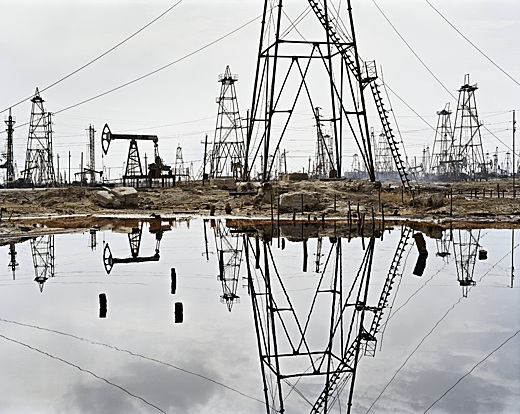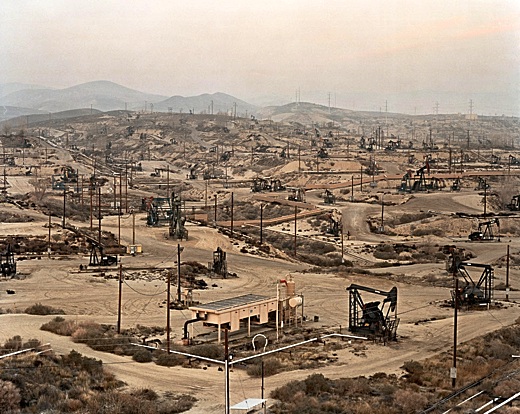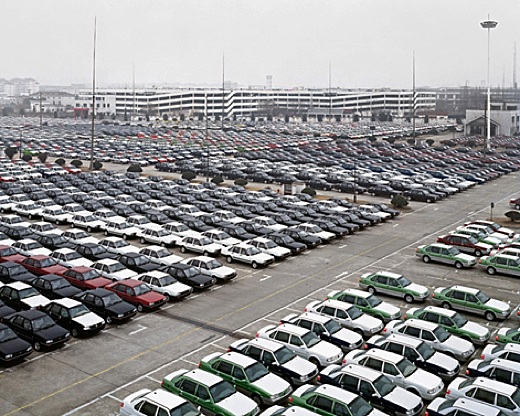SUBHEAD: A decade of photographs exploring the impact of oil from the acclaimed Canadian photographer Edward Burtynsky.
By Conor Risch on 30 October 2009 in Photo District News http://www.pdnonline.com/pdn/content_display/features/pdn-online/e3iebae8a5c132016bc1cfc75b28d34dafb

Image above: Photograph of oil Field #3 in Baku, Ajerbaijan by Edward Burtynsky 2006 From http://www.pdnphotooftheday.com/2009/10/2461
Whether photographing a shoe factory in China, a rock quarry in Portugal or a copper mine in Chile, Edward Burtynsky creates images that use scale to consider the magnitude of human industry and its impact on the landscape. “To me, what’s interesting as art is to begin to define that theater of industry that is almost beyond our imagination,” Burtynsky says.
His most recent long-term project, OIL (see http://www.edwardburtynsky.com), is currently showing simultaneously at the Corcoran Gallery of Art in Washington, D.C., at Hasted Hunt Kraeutler in New York and at Nicholas Metivier Gallery in Toronto. The project was also recently released as a book by Steidl. OIL isn’t meant as an encompassing documentation of the vast global oil production system.
Instead it focuses on major themes—oil extraction and refinement, “motor culture,” and the eventual end of the production and consumption of oil. Burtynsky chose what to photograph after “meditating on the idea of oil and what it’s done to build our world.” Burtynsky felt Los Angeles, where freeway systems and suburbia originated, was important to the work, so he used a helicopter to photograph the city and its major traffic arteries. He also created a sub-essay on Detroit, the “cradle of the automobile.”
A believer in the concept of “Peak Oil”—the point at which global oil production will hit its apex and supplies will rapidly dissapear to calamitous effect—Burtynsky chose to photograph the rapidly growing Las Vegas suburbs and recreational activities like NASCAR races and the Sturgis Motorcycle Rally to look at oil-fueled culture before they're obsolete. He explains, “My thought was, if we are at that crest [in the oil supply], and many believe we are cresting, what are the kinds of things that I can photograph today that may not be here in 50 years?”

Image above: Photograph of oil Field #13 inTaft, California by Edward Burtynsky 2002 From http://www.pdnphotooftheday.com/2009/10/2461
He photographed California’s oil fields, where the first massive discoveries of oil fueled the development of the automotive industry. Those images, along with photographs of oil fields in Alberta and refineries in Ontario and Texas, represent current extraction and production infrastructure. What will the world look like after oil is used up? Burtynsky found the answer in Azerbijan were he photographed former oil fields and offshore rigs abandoned by the Soviets after the deposits were sucked dry. He photographed a repository for decommissioned military aircraft, which sit in vast rows in the Arizona desert.
Scenes of shipbreaking in Bangladesh, and photographs of mountains of old tires and automobile parts also hint at life after oil. Though Burtynsky prefers to leave his images open to interpretation, the urgency of the subject of oil pushes him toward advocacy, he says. “We need to pay attention, this is now, and if our head’s in the sand and we don’t think that we have a problem, we better get it out of the sand quick.”

Image above: Photograph of new Vokswagens parked in Shanghai, China, by Edward Burtynsky 2005 From http://www.pdnphotooftheday.com/2009/10/2461
While there's a message behind his OIL images, Burtynsky chose to compose his shots using the same unobtrusive strategy he defined in 1983, when he photographed railway cuts through Canadian mountain ranges. When he began the project, he was making landscapes as Carleton Watkins might have. “You can picture it: the mountains and the valley and the train snaking in a perfect s-curve with a steam engine and the river to the left,” he says.
“It’s a glorifying point of view of the majestic scenery, of the engineering marvel of man chugging through the mountain passes.” By photographing the ribbon of rail head on, he explains, "I have taken out that heroic view and gone to a view where it’s still the rail, but now it maybe makes one think, ‘What does that ribbon of steel going through that landscape represent?’”
Whether viewers see a marvel of engineering, a scar in the landscape or something in between, any interpretation is valid. Burtynsky says. “Once I have them standing in front of the print wondering ‘What is this place?’ and ‘How could that be?’ or whatever the questions are, I’ve already got them.” Though his project deals with a hot-button issue, Burtynsky feels the work has the greatest impact when exhibited as fine art, rather than being published as photojournalism. His work “shares in journalism,” he says. “I understand that… it has an editorial aspect to it, but nothing I photograph is really a news event….
It’s not an accident, it’s not a disaster, it’s what we’ve done, it’s a conscious act. It’s a story about how we’re evolving our society.” Exhibitions, like the 60-print show at the Corcoran Gallery of Art, which Burtynsky calls “one of the nicest installations of my work,” present the best opportunity for viewers to engage with his large, detailed prints and understand the story Burtynsky is trying to tell, not just with OIL, but with all of his work.
“These landscapes represent the yin to the yang, the destruction to the creation—we create our cities, our industries and our cars and our jets, and there’s a void in the landscape where this stuff comes from, so I believe these landscapes also begin to describe the values and the desires of our societies, the things that we [do] in pursuit of survival and comfort, and their expression in the landscape.”
See also:
More Burtynsky photos on PDN Photo of the Day
http://www.foreignpolicy.com/articles/2009/10/09/edward_burtynskys_oil?page=0,9
By Conor Risch on 30 October 2009 in Photo District News http://www.pdnonline.com/pdn/content_display/features/pdn-online/e3iebae8a5c132016bc1cfc75b28d34dafb

Image above: Photograph of oil Field #3 in Baku, Ajerbaijan by Edward Burtynsky 2006 From http://www.pdnphotooftheday.com/2009/10/2461
Whether photographing a shoe factory in China, a rock quarry in Portugal or a copper mine in Chile, Edward Burtynsky creates images that use scale to consider the magnitude of human industry and its impact on the landscape. “To me, what’s interesting as art is to begin to define that theater of industry that is almost beyond our imagination,” Burtynsky says.
His most recent long-term project, OIL (see http://www.edwardburtynsky.com), is currently showing simultaneously at the Corcoran Gallery of Art in Washington, D.C., at Hasted Hunt Kraeutler in New York and at Nicholas Metivier Gallery in Toronto. The project was also recently released as a book by Steidl. OIL isn’t meant as an encompassing documentation of the vast global oil production system.
Instead it focuses on major themes—oil extraction and refinement, “motor culture,” and the eventual end of the production and consumption of oil. Burtynsky chose what to photograph after “meditating on the idea of oil and what it’s done to build our world.” Burtynsky felt Los Angeles, where freeway systems and suburbia originated, was important to the work, so he used a helicopter to photograph the city and its major traffic arteries. He also created a sub-essay on Detroit, the “cradle of the automobile.”
A believer in the concept of “Peak Oil”—the point at which global oil production will hit its apex and supplies will rapidly dissapear to calamitous effect—Burtynsky chose to photograph the rapidly growing Las Vegas suburbs and recreational activities like NASCAR races and the Sturgis Motorcycle Rally to look at oil-fueled culture before they're obsolete. He explains, “My thought was, if we are at that crest [in the oil supply], and many believe we are cresting, what are the kinds of things that I can photograph today that may not be here in 50 years?”

Image above: Photograph of oil Field #13 inTaft, California by Edward Burtynsky 2002 From http://www.pdnphotooftheday.com/2009/10/2461
He photographed California’s oil fields, where the first massive discoveries of oil fueled the development of the automotive industry. Those images, along with photographs of oil fields in Alberta and refineries in Ontario and Texas, represent current extraction and production infrastructure. What will the world look like after oil is used up? Burtynsky found the answer in Azerbijan were he photographed former oil fields and offshore rigs abandoned by the Soviets after the deposits were sucked dry. He photographed a repository for decommissioned military aircraft, which sit in vast rows in the Arizona desert.
Scenes of shipbreaking in Bangladesh, and photographs of mountains of old tires and automobile parts also hint at life after oil. Though Burtynsky prefers to leave his images open to interpretation, the urgency of the subject of oil pushes him toward advocacy, he says. “We need to pay attention, this is now, and if our head’s in the sand and we don’t think that we have a problem, we better get it out of the sand quick.”

Image above: Photograph of new Vokswagens parked in Shanghai, China, by Edward Burtynsky 2005 From http://www.pdnphotooftheday.com/2009/10/2461
While there's a message behind his OIL images, Burtynsky chose to compose his shots using the same unobtrusive strategy he defined in 1983, when he photographed railway cuts through Canadian mountain ranges. When he began the project, he was making landscapes as Carleton Watkins might have. “You can picture it: the mountains and the valley and the train snaking in a perfect s-curve with a steam engine and the river to the left,” he says.
“It’s a glorifying point of view of the majestic scenery, of the engineering marvel of man chugging through the mountain passes.” By photographing the ribbon of rail head on, he explains, "I have taken out that heroic view and gone to a view where it’s still the rail, but now it maybe makes one think, ‘What does that ribbon of steel going through that landscape represent?’”
Whether viewers see a marvel of engineering, a scar in the landscape or something in between, any interpretation is valid. Burtynsky says. “Once I have them standing in front of the print wondering ‘What is this place?’ and ‘How could that be?’ or whatever the questions are, I’ve already got them.” Though his project deals with a hot-button issue, Burtynsky feels the work has the greatest impact when exhibited as fine art, rather than being published as photojournalism. His work “shares in journalism,” he says. “I understand that… it has an editorial aspect to it, but nothing I photograph is really a news event….
It’s not an accident, it’s not a disaster, it’s what we’ve done, it’s a conscious act. It’s a story about how we’re evolving our society.” Exhibitions, like the 60-print show at the Corcoran Gallery of Art, which Burtynsky calls “one of the nicest installations of my work,” present the best opportunity for viewers to engage with his large, detailed prints and understand the story Burtynsky is trying to tell, not just with OIL, but with all of his work.
“These landscapes represent the yin to the yang, the destruction to the creation—we create our cities, our industries and our cars and our jets, and there’s a void in the landscape where this stuff comes from, so I believe these landscapes also begin to describe the values and the desires of our societies, the things that we [do] in pursuit of survival and comfort, and their expression in the landscape.”
See also:
More Burtynsky photos on PDN Photo of the Day
No comments :
Post a Comment